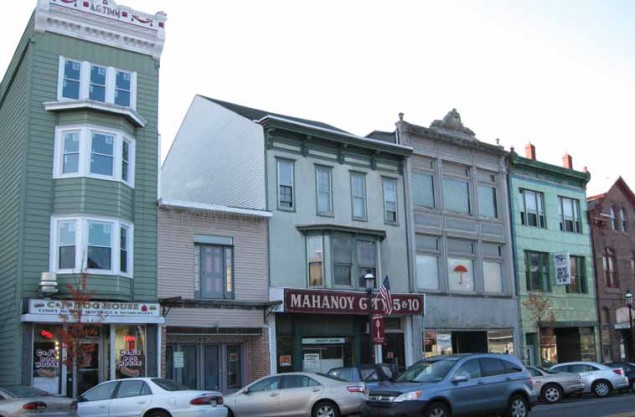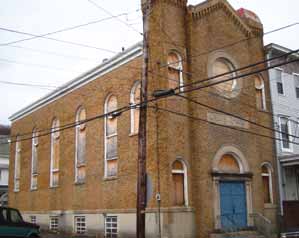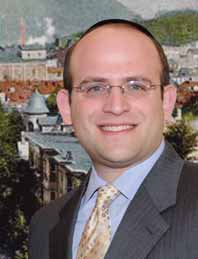The Story of Mahanoy City: The Disappearance of a Jewish Community in a Small American Town
 A main street in present-day Mahanoy City. Photo: Wikipedia Commons/Doug Kerr
A main street in present-day Mahanoy City. Photo: Wikipedia Commons/Doug Kerr
The disappearance of a Jewish community in a small mining town in Pennsylvania sheds light on the disappearance of many other small Jewish communities that once dotted the American landscape.
An Unusual Request
As Kesher Israel Congregation, the shul where I serve as the rabbi in Harrisburg, Pennsylvania, is about a twenty-five minute drive from Hersheypark, I get a kick out of answering visitors’ questions each year around Sukkot time.
During Chol Hamoed Sukkot this past year, however, my cell phone rang with a completely different kind of call.
“My grandfather passed away several days ago, and we’re looking for a rabbi who can officiate at his funeral. Can you help us?” asked a young Jewish woman whom I had never met.
The night before the funeral, I met with the family and learned that the deceased had been born and raised in a small Jewish community that once existed in Mahanoy City (about an hour and a half northeast of Harrisburg). I was surprised to hear that he had lived there, as I had not known that Jewish communities—of any size—had once existed among Pennsylvania’s rough-and-tumble coal-mining towns.
I made a mental note to find out more about the history of Mahanoy City’s now-vanished Jewish community. In the days that followed, I could not find any information online and decided that I would drive out to Mahanoy City to research the “old fashioned way.”
Several weeks later, my wife Layala and I visited Mahanoy City. The town is rather small, and one can sense that with mining long gone, the town and its residents are in an economic depression.
We parked our car along the main street and walked into a small shop. The store owner had vague memories of a synagogue that once functioned in Mahanoy City, but she could not say where it was located. She gave us the name of the only Jewish woman still living in town and informed us that the woman’s late husband had owned a shirt factory that had employed many of the women in the town. She had fond memories of her long-gone Jewish neighbors, but was not able to help us any further.
 Mahanoy City’s Jewish community laid the cornerstone for Beth Israel Congregation in 1923. Today, the abandoned shul stands as a testimony to the small Jewish community that once existed there. Photos courtesy of Rabbi Males
Mahanoy City’s Jewish community laid the cornerstone for Beth Israel Congregation in 1923. Today, the abandoned shul stands as a testimony to the small Jewish community that once existed there. Photos courtesy of Rabbi Males
Stopping to speak with an elderly mechanic outside his shop, we discovered where the shul was located. We soon stood before a tall, narrow structure, locked and boarded up, perched on the corner of a modest block of row-houses. As we took in the sight, we were struck by how out of place the shul seemed to be.
The words Congregation Beth Israel in Hebrew appeared prominently above the doors. The building’s other inscription was located on its cornerstone—1923. While gazing at the building, we imagined the excited crowd that must have been present almost ninety years earlier when the cornerstone was laid. Sadly, in 2011, nothing of that Jewish community remained.
So many questions raced through my mind: When and why did Jewish families arrive in Mahanoy City? What was Jewish life like for the members of Congregation Beth Israel? Why did the shul shut its doors?
The Last Jew of Mahanoy City
A passerby suggested we visit the woman up the block who was the last Jewish resident of Mahanoy City. We arrived at the modest home, noticed a mezuzah affixed to the doorpost and rang the bell. When nobody answered, a friendly neighbor emerged and asked if he could be of any help. I explained that we were in town hoping to learn more about Mahanoy City’s all but forgotten Jewish community. While he had no information to share, he assured us that he would pass on my contact information to his neighbor whom we were hoping to meet.
Later that night, back at the hotel, I received a phone call from Mahanoy City’s last Jewish resident. We had a pleasant conversation, and she truly appreciated my interest in the history of her town’s Jewish community. While she provided me with additional leads and was able to answer a few of my questions, so many more remained unanswered.
 Tombstone of the sheimot of Beth Israel Congregation in Mahanoy City’s Jewish cemetery, established in 1932.
Tombstone of the sheimot of Beth Israel Congregation in Mahanoy City’s Jewish cemetery, established in 1932.
The next morning, I visited the town’s small, well-kept Jewish cemetery. Like the shul, the cemetery—with its Hebrew-engraved tombstones—seemed incredibly out of place.
One of the tombstones I came across marked the site where the shul had buried its sheimot in 1937.
In the months that followed, I pursued many different leads in my quest to find out more about the history of the Jewish community of Mahanoy City. I spoke with several people who had grown up there. I also tracked down and spoke with the rabbi who served Mahanoy City’s Jewish community from 1948 to 1955 (he is now retired and living in Florida).
What follows is a composite sketch of the Jewish community that once existed in Mahanoy City, based upon information I was able to dig up.
Birth of a Jewish Community
Upon arriving in America in the late 1800s, many Jewish immigrants were faced with the same problem—earning a living. They were forced to peddle various goods, but the markets in the large immigrant centers were already saturated with peddlers. Many enterprising immigrants began searching for better locales to peddle their wares. Word spread that with so much less competition, a hard-working peddler in Pennsylvania’s small coal-mining towns had a better chance of making a living—and maybe even opening a successful store—than he could ever dream of back in the big cities.
Before long, Jewish peddlers, shopkeepers, and small business owners became a common sight in the small towns throughout the coal-mining region. (I was repeatedly told, however, that no Jews ever became actual coal miners.) As more and more Jewish immigrants made their way to America’s welcoming shores, many joined their family members or friends from the “Old Country” in those locales. Small Jewish communities throughout the mountainous Pennsylvania coal region began to appear.
One such community was in the small mining town of Mahanoy City. The Jewish peddlers and their children prospered and were respected by the town’s miners for their honesty, charity and work ethic. At the height of the town’s economic boom, a few Jewish-owned local clothing factories existed and employed many local miners’ wives. Traveling meshulachim making the rounds of the coal region’s small Jewish communities would stop in Mahanoy City.
As Mahanoy City’s Jewish community never numbered more than about fifty families, its members did their best to socialize with and share as many events as possible with other small Jewish communities in the coal region—particularly Shenandoah and Frackville. A small three-story home was purchased and became Mahanoy City’s Jewish Community Center. Aside from housing a Hebrew school, the JCC also served as the hub for the Jewish community’s social and recreational activities.
By 1923, Mahanoy City’s Jewish community was able to lay the cornerstone for a respectable new synagogue. The town’s Jewish cemetery was established in 1932.
Sadly, for the most part, religious observance among many members of Mahanoy City’s Jewish community waned, similar to what occurred in so many other Jewish immigrant communities across the United States. 1
For those who remained observant, traveling shochetim would make their way through the Jewish communities of the coal region to properly slaughter chickens. Though Mahanoy City never had its own mikvah, members would frequent the mikvah in nearby Hazleton, Pennsylvania. And most of the people I interviewed told me that their grandparents had two sets of dishes and would celebrate Pesach in a traditional manner.
 Rabbi Akiva Males, of Kesher Israel Congregation in Harrisburg, Pennsylvania.
Rabbi Akiva Males, of Kesher Israel Congregation in Harrisburg, Pennsylvania.
The Decline of a Community
By the late 1940s, the shul’s minyan only met consistently on Friday nights (about twenty-five to thirty people attended) and Sunday mornings (followed by a light breakfast). The Shabbat morning minyan only attempted to meet every other week, and even that was a challenge.
As Sabbath observance declined in Mahanoy City, it became ever more difficult for the shul to continue its Shabbat morning minyan. One man told me that as a young boy in the 1940s, he was a regular at shul on Shabbat mornings. If they did not have the requisite ten men for the minyan, some of the older congregants would send him next door to telephone one of the nearby Jewish-owned factories. The factory owners would permit the precise number of men needed to temporarily leave work in order to assist the shul’s struggling minyan.
By the mid-1950s, the balcony was no longer in use. Men and women sat in the main sanctuary—with no mechitzah between—and Congregation Beth Israel aligned itself with the Conservative movement. 2
By the late 1950s, Mahanoy City’s Jewish community began its rapid decline. As the synagogue’s membership fell, the shul could only afford to hire a rabbi for the High Holy Days. Congregation Beth Israel gave up trying to organize regular services by the 1970s. With the building used so infrequently, in 2003 the few remaining members sold off the synagogue’s sifrei Torah and stained glass windows, and the doors were locked and boarded up.
How many more vanished American Jewish communities like Mahanoy City are out there? How many more are there yet to be?
Though it has been less than 100 years since its cornerstone was laid, no one officially owns Congregation Beth Israel’s building anymore. As it is too expensive for the city to tear the structure down, the abandoned shul with its Hebrew inscriptions stands as a matzeivah (tombstone) of sorts to the Jewish community that once existed.
The families of those buried in Mahanoy City’s Jewish cemetery are putting together a plan to ensure its upkeep.
The Death of a Community
What caused Mahanoy City’s Jewish community to decline and eventually disappear? When I asked that question to the people I interviewed, I received the same answers:
1) The older generation passed away.
2) The younger generation left for schooling and better job opportunities.
3) As the country moved away from using coal as a fuel, local mining operations all but ceased, and the region’s economy declined. With so few economic opportunities in the area, no new Jewish families moved in to replace those who had left.
The more I learned about the history of Mahanoy City’s Jewish community, the more I realized how its story mirrors that of so many smaller Jewish communities that once existed across America.
Recently, I noticed this item in Harrisburg’s Jewish newspaper:
Throughout the United States, Jewish communities sprung up as itinerant merchants (“peddlers”) settled to provide goods for local areas. Small towns throughout the nation had main streets lined with Jewish businesses. Each of these communities had synagogues and Jewish cemeteries.
Throughout Pennsylvania, Jewish communities thrived as the steel mills, coal mines, and shmata (clothing) factories provided solid economic bases for local Jewish merchants.
But times change. Mining, steel making, and clothing manufacturing are all but gone from the area. “Main Street” has been replaced by Wal-Mart and the shopping mall filled with national chain stores. The Jewish-owned small business is a fast dying memory.
The offspring of the merchants of these towns had no reason to return to the communities following their college years. Instead, they migrated to the major communities, leaving the old towns with one or two, or, in many instances, no Jewish families remaining . . . 3
Though other factors certainly play a role, the fate of any Jewish community is tied to its local economy. This is especially true of Orthodox communities whose membership requires a mikvah, day school, and consistent minyan. None of those institutions can be sustained without a critical mass of community members willing to maintain them.
Since I began researching Mahanoy City’s Jewish community, I find myself haunted by the following questions: How many more vanished American Jewish communities like Mahanoy City are out there? How many more are there yet to be?
Notes
1. For an excellent article dealing with religious observance among Jewish immigrants and their descendants, see Jeffrey S. Gurock, “The Winnowing of American Orthodoxy” in American Jewish Orthodoxy in Historical Perspective (New Jersey, 1996), 299-312.
2. For a sense of just how common this phenomenon was in America at that time, see Baruch Litvin, Sanctity of the Synagogue (New Jersey, 1987).
3. Howard Ross, “The Cemeteries are Dying!” Community Review, November 19, 2010, page 4.
Rabbi Akiva Males serves as rabbi of Harrisburg’s Kesher Israel Congregation, an OU-member synagogue. He and his wife Layala moved from Kew Gardens Hills, New York to Pennsylvania in 2007.
